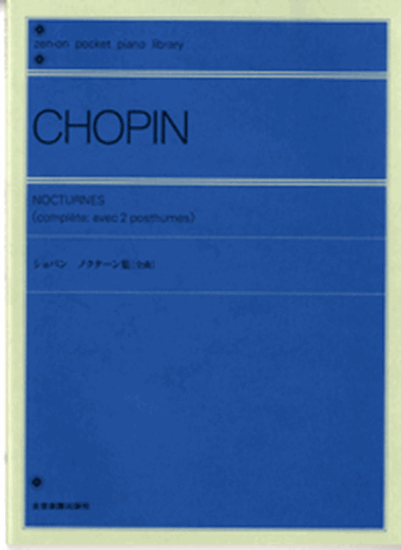Chopin, Frederic : Nocturne no.19 e-moll Op.72-1
Work Overview
Publication Year:1855
First Publisher:Berlin
Instrumentation:Piano Solo
Genre:nocturne
Total Playing Time:3 min 30 sec
Copyright:Public Domain
Additional Notes:ノクターン番号はパデレフスキ版による。
Commentary (1)
Author : Hayashikawa, Takashi
Last Updated: January 1, 2010
[Open]
Author : Hayashikawa, Takashi
Nocturne Op.72 No.1
Chopin's first nocturne, believed to have been composed in 1827. The opus number Op. 72-1 was assigned by Chopin's friend, Julian Fontana. For some reason, Fontana's first edition published this nocturne as a set with the Funeral March Op. 72-2 and Three Écossaises Op. 72-3, leading to these works of entirely different genres being assigned the same opus number. This work was first published in Paris (J. Meissonier fils) and Berlin (A. M. Schlesinger).
It adopts an A-B-A'-B' structure with a one-measure introduction and a short coda. The first A section concludes in the dominant key of B major, followed by B in B major. The second A' section concludes in the parallel key of E major, followed by B' in E major. This can be schematized as follows:
Figure 1
Throughout the entire piece, there is no section that concludes on the tonic of E minor, and a conclusion on the tonic of E major does not appear until the end of A'. In contrast to the A section, which has considerable undulation and length (the A section is 21 measures long excluding the introduction, and A' is 16 measures), the B section consists only of a flat, four-measure phrase appearing twice in varied forms (Figure 2).
Figure 2
A : B : A’ : B’=21 : 8 : 16 : 8
Due to these structural characteristics, aurally, it rather feels as if a single large flow of [A-B-A'] is created with B acting as a transition, and B' assumes the role of a coda. Throughout the piece, the right hand sings the melody over a consistent triplet accompaniment in the left hand. The accompaniment, however, incorporates movements such as the non-harmonic tone (C natural) on the middle note of the second and fourth beats in the pattern appearing from the first measure, the melodic movement of the left hand on the second to fourth beats in measures 7-8, and the stepwise motion on the second and fourth beats of the pattern in the B section, thereby acquiring delicate expression and variation. Meanwhile, the right hand also features, particularly in the inner voices, chromatic voice leading (m. 12), contrapuntal motion (mm. 14, 19, Music Example 1), and imitation of rhythmic motifs (mm. 23-24, 29-30, Music Examples 2a, 2b), adding variation to the music.
Music Example 1: Measures 19-22, showing contrapuntal voice writing in the right hand.
Music Example 2a: Rhythmic motif appearing in measures 23-24.
Music Example 2b: Measures 29-30, rhythmic motif imitated in the inner voice.
Contrapuntal voice writing and the skillful manipulation of motifs are characteristics particularly observed in Chopin's nocturnes from the 1840s. However, this work is an early composition, undertaken by Chopin in his late teens during his student years.Piano Sonata No. 1 This aspiration for academic writing, also seen in the Piano Sonata No. 1, is likely largely attributable to the influence of his composition teacher, the Polish master Józef Elsner.
Sheet Music
Scores List (12)

(株)全音楽譜出版社

ハンナ(ショパン)

(株)ドレミ楽譜出版社

(株)全音楽譜出版社

(株)全音楽譜出版社

(株)音楽之友社

(株)全音楽譜出版社

(株)全音楽譜出版社

ポーランド音楽出版社

(株)ヤマハミュージックエンタテインメントホールディングス

(株)音楽之友社


